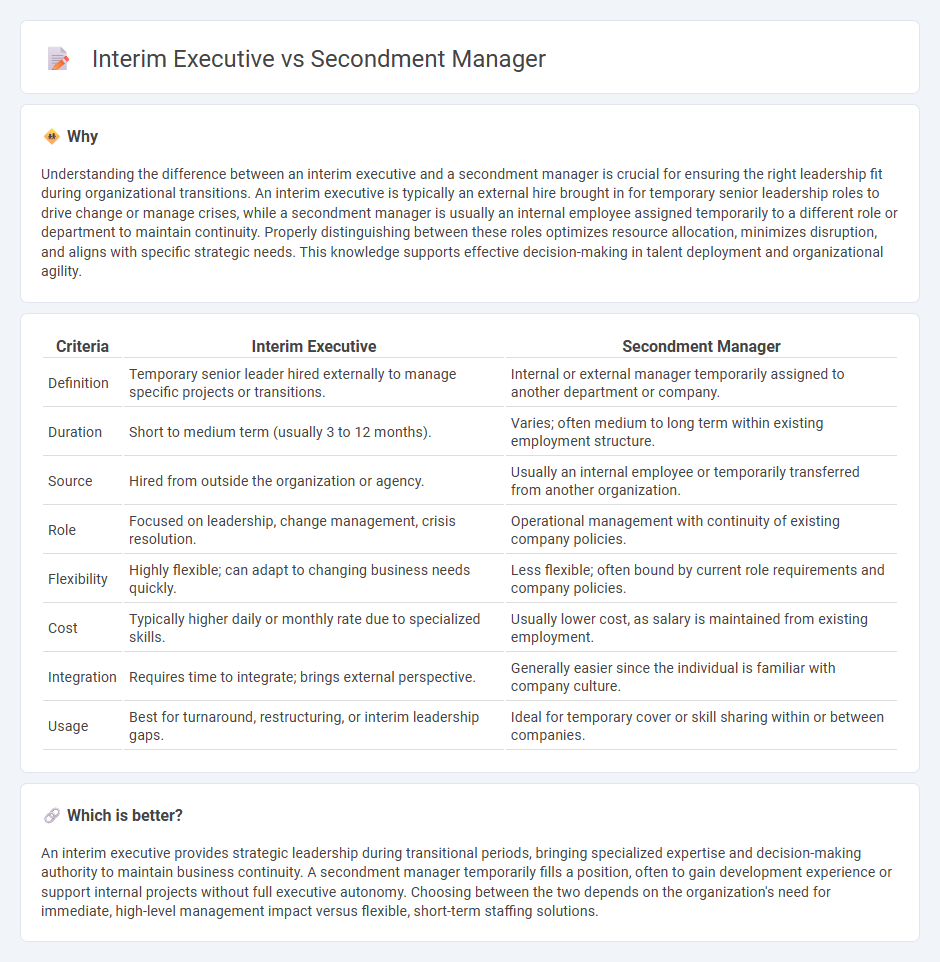
Interim executives are experienced leaders appointed temporarily to fill senior management roles and drive strategic initiatives during periods of transition or crisis. Secondment managers are typically internal employees assigned temporarily to a different department or organization to provide expertise while maintaining their original employment status. Explore the distinct advantages and applications of interim executives and secondment managers to optimize your management strategy.
Why it is important
Understanding the difference between an interim executive and a secondment manager is crucial for ensuring the right leadership fit during organizational transitions. An interim executive is typically an external hire brought in for temporary senior leadership roles to drive change or manage crises, while a secondment manager is usually an internal employee assigned temporarily to a different role or department to maintain continuity. Properly distinguishing between these roles optimizes resource allocation, minimizes disruption, and aligns with specific strategic needs. This knowledge supports effective decision-making in talent deployment and organizational agility.
Comparison Table
| Criteria | Interim Executive | Secondment Manager |
|---|---|---|
| Definition | Temporary senior leader hired externally to manage specific projects or transitions. | Internal or external manager temporarily assigned to another department or company. |
| Duration | Short to medium term (usually 3 to 12 months). | Varies; often medium to long term within existing employment structure. |
| Source | Hired from outside the organization or agency. | Usually an internal employee or temporarily transferred from another organization. |
| Role | Focused on leadership, change management, crisis resolution. | Operational management with continuity of existing company policies. |
| Flexibility | Highly flexible; can adapt to changing business needs quickly. | Less flexible; often bound by current role requirements and company policies. |
| Cost | Typically higher daily or monthly rate due to specialized skills. | Usually lower cost, as salary is maintained from existing employment. |
| Integration | Requires time to integrate; brings external perspective. | Generally easier since the individual is familiar with company culture. |
| Usage | Best for turnaround, restructuring, or interim leadership gaps. | Ideal for temporary cover or skill sharing within or between companies. |
Which is better?
An interim executive provides strategic leadership during transitional periods, bringing specialized expertise and decision-making authority to maintain business continuity. A secondment manager temporarily fills a position, often to gain development experience or support internal projects without full executive autonomy. Choosing between the two depends on the organization's need for immediate, high-level management impact versus flexible, short-term staffing solutions.
Connection
Interim executives and secondment managers both provide temporary leadership solutions that address critical gaps or specific project needs within organizations. These roles enable seamless transitions by leveraging experienced professionals who integrate quickly and drive strategic objectives without long-term commitment. Companies benefit from their expertise to maintain operational continuity and execute change management effectively.
Key Terms
Temporary Assignment
Secondment managers oversee the temporary transfer of employees within or between organizations, ensuring smooth transitions and continuity during the assignment period. Interim executives are seasoned professionals hired for a short-term leadership role to address specific challenges or fill critical gaps, often bringing strategic expertise to drive immediate results. Explore the key differences and benefits of secondment managers versus interim executives in temporary assignments to optimize organizational success.
Organizational Integration
A secondment manager facilitates seamless organizational integration by temporarily embedding within existing teams to transfer skills and align practices with company culture. Interim executives, while also providing leadership during transitions, typically focus on strategic decision-making and crisis management rather than deep integration. Discover how each role can uniquely support your organization's structural and cultural needs.
Change Leadership
Secondment managers are often embedded within an organization to lead transformative projects, utilizing their deep understanding of company culture to drive sustained change leadership. Interim executives, typically appointed for shorter durations, bring external expertise and strategic oversight to rapidly implement change and stabilize leadership during transitions. Explore the distinct roles and benefits of each to enhance your organization's change initiatives.
Source and External Links
Decoding Secondment Meaning & Seconded Employees Roles - This article discusses the concept of secondment, including how it works and its benefits for employees.
What is secondment? (With benefits and examples) - This article explains secondment as a temporary work placement, often used to gain new experiences and skills.
What is a secondment, and why is it valuable for your career? - This blog post highlights the career benefits of secondments, including gaining new experiences and networking opportunities.
 dowidth.com
dowidth.com